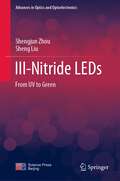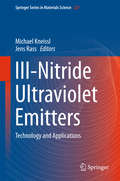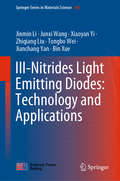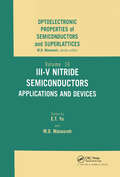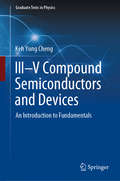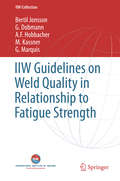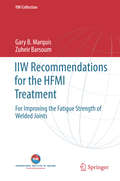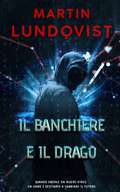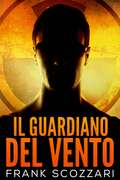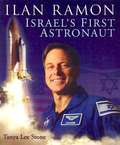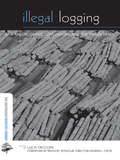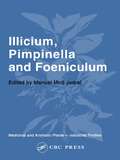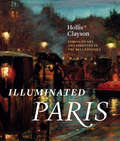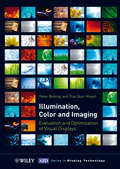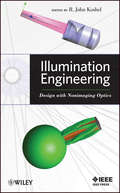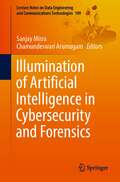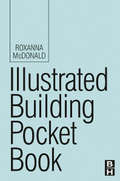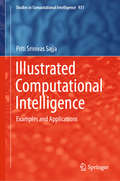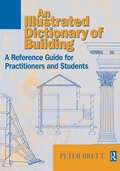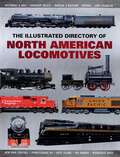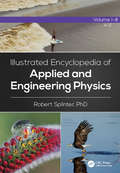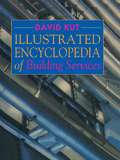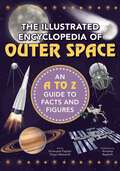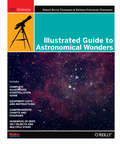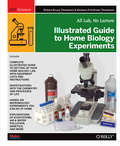- Table View
- List View
III-Nitride LEDs: From UV to Green (Advances in Optics and Optoelectronics)
by Shengjun Zhou Sheng LiuThis book highlights state-of-the-art in III-nitrides-based light-emitting diodes (LEDs). Motivated by the application prospects in lighting, high-resolution display, and health & medicine, the book systematically introduces the physical fundamentals, epitaxial growth, and device fabrications of III-nitride-based LEDs. Important topics including the structures of chips, device reliability and measurements and the advances in mini and micro LEDs are also discussed. The book is completed with a decade of research experience of the author’s team in the design and fabrication of III-nitrides-based LEDs, presenting the novel achievements in the stress control of the large mismatch heterostructures, defect formation and inhibition mechanism of the heteroepitaxial growth, LED epitaxial technologies, and the fabrication of high-efficient flip-chip LEDs. The book comprises of a valuable reference source for researchers and professionals engaged in the research and development of III-nitrides-based LEDs.
III-Nitride Ultraviolet Emitters
by Michael Kneissl Jens RassThis book provides a comprehensive overview of the state-of-the-art in group III-nitride based ultraviolet LED and laser technologies, covering different substrate approaches, a review of optical, electronic and structural properties of InAlGaN materials as well as various optoelectronic components. In addition, the book gives an overview of a number of key application areas for UV emitters and detectors, including water purification, phototherapy, sensing, and UV curing. The book is written for researchers and graduate level students in the area of semiconductor materials, optoelectronics and devices as well as developers and engineers in the various application fields of UV emitters and detectors.
III-Nitrides Light Emitting Diodes: Technology and Applications (Springer Series in Materials Science #306)
by Jinmin Li Junxi Wang Xiaoyan Yi Zhiqiang Liu Tongbo Wei Jianchang Yan Bin XueThe book provides an overview of III-nitride-material-based light-emitting diode (LED) technology, from the basic material physics to the latest advances in the field, such as homoepitaxy and heteroepitaxy of the materials on different substrates. It also includes the latest advances in the field, such as approaches to improve quantum efficiency and reliability as well as novel structured LEDs. It explores the concept of material growth, chip structure, packaging, reliability and application of LEDs. With spectra coverage from ultraviolet (UV) to entire visible light wavelength, the III-nitride-material-based LEDs have a broad application potential, and are not just limited to illumination. These novel applications, such as health & medical, visible light communications, fishery and horticulture, are also discussed in the book.
III-V Nitride Semiconductors: Applications and Devices
by Edward T. YuThe concepts in this book will provide a comprehensive overview of the current state for a broad range of nitride semiconductor devices, as well as a detailed introduction to selected materials and processing issues of general relevance for these applications. This compilation is very timely given the level of interest and the current stage of research in nitride semiconductor materials and device applications. This volume consists of chapters written by a number of leading researchers in nitride materials and device technology addressing Ohmic and Schottky contacts, AIGalnN multiple quantum well laser diodes, nitride vertical cavity emitting lasers, and ultraviolet photodetectors. This unique volume provides a comprehensive review and introduction to application and devices based on GaN and related compounds for newcomers to the field and stimulus to further advances for experienced researchers.
III–V Compound Semiconductors and Devices: An Introduction to Fundamentals (Graduate Texts in Physics)
by Keh Yung ChengThis textbook gives a complete and fundamental introduction to the properties of III-V compound semiconductor devices, highlighting the theoretical and practical aspects of their device physics. Beginning with an introduction to the basics of semiconductor physics, it presents an overview of the physics and preparation of compound semiconductor materials, as well as a detailed look at the electrical and optical properties of compound semiconductor heterostructures. The book concludes with chapters dedicated to a number of heterostructure electronic and photonic devices, including the high-electron-mobility transistor, the heterojunction bipolar transistor, lasers, unipolar photonic devices, and integrated optoelectronic devices. Featuring chapter-end problems, suggested references for further reading, as well as clear, didactic schematics accompanied by six information-rich appendices, this textbook is ideal for graduate students in the areas of semiconductor physics or electrical engineering. In addition, up-to-date results from published research make this textbook especially well-suited as a self-study and reference guide for engineers and researchers in related industries.
IIW Guidelines on Weld Quality in Relationship to Fatigue Strength
by Bertil Jonsson G. Dobmann A. F. Hobbacher M. Kassner G. MarquisThis book presents guidelines on quantitative and qualitative measures of the geometric features and imperfections of welds to ensure that it meets the fatigue strength requirements laid out in the recommendations of the IIW (International Institute of Welding). Welds that satisfy these quality criteria can be assessed in accordance with existing IIW recommendations based on nominal stress, structural stress, notch stress or linear fracture mechanics. Further, the book defines more restrictive acceptance criteria based on weld geometry features and imperfections with increased fatigue strength. Fatigue strength for these welds is defined as S-N curves expressed in terms of nominal applied stress or hot spot stress. Where appropriate, reference is made to existing quality systems for welds. In addition to the acceptance criteria and fatigue assessment curves, the book also provides guidance on their inspection and quality control. The successful implementation of these methods depends on adequate training for operators and inspectors alike. As such, the publication of the present IIW Recommendations is intended to encourage the production of appropriate training aids and guidelines for educating, training and certifying operators and inspectors.
IIW Recommendations for the HFMI Treatment
by Gary B. Marquis Zuheir BarsoumThis book of recommendations presents an overview of High Frequency Mechanical Impact (HFMI) techniques existing today in the market and their proper procedures, quality assurance measures and documentation. Due to differences in HFMI tools and the wide variety of potential applications, certain details of proper treatments and quantitative quality control measures are presented generally. An example of procedure specification as a quality assurance measure is given in the Appendix. Moreover, the book presents procedures for the fatigue life assessment of HFMI-improved welded joints based on nominal stress, structural hot spot stress and effective notch stress. It also considers the extra benefit that has been experimentally observed for HFMI-treated high-strength steels. The recommendations offer proposals on the effect of loading conditions like high mean stress fatigue cycles, variable amplitude loading and large amplitude/low cycle fatigue cycles. Special considerations for low stress concentration welded joints are also given. In order to demonstrate the use of the guideline, the book provides several fatigue assessment examples.
Il Banchiere e il Drago
by Martin LundqvistQuando emerge un nuovo virus, un uomo è destinato a cambiare il futuro. L'agente australiano Jared Pond viene inviato per indagare sulle voci su una nuova arma biologica cinese, il virus Hei Bai. Durante il suo incarico, Jared incontra e si innamora dell'attivista cinese per i diritti civili Eileen Lu, nemica del CPOC. Insieme, Jared ed Eileen cercano di scoprire gli oscuri segreti del malvagio dittatore Presidente Jing Xi e del suo assistente Tzi Cheng. Ma chi è Pierre Beaumont e qual è il legame tra la diffusione del virus e l'amministratore delegato della Banca mondiale?
Il Guardiano del Vento
by Silvia De Cristofaro Frank ScozzariIn California, una delle più grandi centrali nucleari negli Stati Uniti è presa di mira da un gruppo di terroristi. Aiutati da una talpa,il piano degli estremisti è quello di appropriarsi del reattore e spargere radiazioni nel vento, scatenando caos in tutto il mondo. L'unica cosa che si frappone al loro piano è una coppia di ufficiali di sicurezza ribelli,la cui fuga romantica li elimina temporaneamente dal radar dei terroristi. Dopo essersi resi conto di quello che è successo alla centrale, si ritrovano coinvolti in una battaglia contro il tempo e contro scenari terrificanti. Un'improvvisa rinascita di senso del dovere gli fa prendere le armi e li fa impegnare fino a un punto di non ritorno. Ma la loro chiamata all'azione è arrivata troppo tardi? Esponendo la vulnerabilità delle centrali nucleari della nazione,il Guardiano del Vento è un potente thriller di Frank Scozzari, che ha ricevuto quattro nomination per il Premio Pushcart.
Ilan Ramon: Israel's First Astronaut
by Tanya Lee StoneStone tells of the first Israeli, Ilan Ramon, to travel to space.
Illegal Logging: Law Enforcement, Livelihoods and the Timber Trade
by Luca Tacconi'This book carefully blends conceptual insights with extensive empirical evidence to navigate the reader through an issue that is still poorly understood [and is] a valuable reference for the development practitioner to understand the fundamental causes of illegal logging, its myriad consequences and the policy choices available to address the problem' Nalin Kishor, Forest Law Enforcement and Governance Coordinator, The World Bank 'An excellent resource for those working to conserve and sustainably manage forests worldwide. It offers an extensive and comprehensive study of illegal logging, bringing together the knowledge and views of experts who examine its roots and social, economic and environmental implications. One of its important contributions is to show that, unless coupled with reform of forestry regulations to take into account local people, law enforcement to curb illegal logging can negatively impact them. Therefore, any effective and fair approach to the problem needs to involve governments, forestry operators and local communities alike' Gonzalo Oviedo, Senior Social Policy Advisor, IUCN In many countries illegal logging now accounts for a large share of the harvest. Once cut, illegal logs feed an insatiable demand for exotic hardwoods in developed and developing countries. The result has been loss of both revenue and biodiversity, and consequently the issue has risen to the top of the global forest policy agenda as one of the major threats to forests, and donors and national governments are starting to develop initiatives to control illegal logging. Yet for such a massive illegal trade, there is surprisingly limited knowledge available as to the major causes of illegal logging and its impacts on biodiversity, people and livelihoods and national economies, and thus plenty of speculation and action without evidence. It is clear that while illegal logging does have negative impacts, it also, controversially, and perhaps paradoxically, benefits many stakeholders, including local communities. This book, written by the world's foremost experts, examines the key issues including law and enforcement, supply and demand, corruption, forest certification, poverty, local livelihoods, international trade and biodiversity conservation. It includes key case studies from forest-rich hotspots in North, South and Central America, equatorial Africa and Indonesia. While there are clearly no easy answers, this book sorts fact from fiction and explores the many dimensions of the causes, impacts and implications for forests, people, livelihoods and forest policy. Published with CIFOR
Illicium, Pimpinella and Foeniculum
by Manuel Miró JodralThe book includes current knowledge on Illicium verum (star anise) and Pimpinella anisum (aniseed), main commercial species rich in anetol. It also analyzes Foeniculum vulgare (fennel) and other species of Pimpinella (P. major, P. peregrina and P. saxifraga). This volume includes a botanical, chemical, pharmacological, and therapeutic survey of the
Illuminated Paris: Essays on Art and Lighting in the Belle Époque
by Hollis ClaysonThe City of Light. For many, these four words instantly conjure late nineteenth-century Paris and the garish colors of Toulouse-Lautrec’s iconic posters. More recently, the Eiffel Tower’s nightly show of sparkling electric lights has come to exemplify our fantasies of Parisian nightlife. Though we reflect longingly on such scenes, in Illuminated Paris, Hollis Clayson shows that there’s more to these clichés than meets the eye. In this richly illustrated book, she traces the dramatic evolution of lighting in Paris and how artists responded to the shifting visual and cultural scenes that resulted from these technologies. While older gas lighting produced a haze of orange, new electric lighting was hardly an improvement: the glare of experimental arc lights—themselves dangerous—left figures looking pale and ghoulish. As Clayson shows, artists’ representations of these new colors and shapes reveal turn-of-the-century concerns about modernization as electric lighting came to represent the harsh glare of rapidly accelerating social change. At the same time, in part thanks to American artists visiting the city, these works of art also produced our enduring romantic view of Parisian glamour and its Belle Époque.
Illumination, Color and Imaging
by Tran Quoc Khanh Peter BodrogiThis much needed, comprehensive and modern reference on display technology, illumination sources and color imaging focuses on visual effects and how reproduced images are best matched to human visual features.As such, it teaches readers how to exploit the knowledge of human color information processing to design usable, ergonomic, and pleasing displays or visual environments. The contents describe design principles and methods to optimize self-luminous visual technologies for the human user, including modern still and motion image displays, and indoor light sources. Design principles and methods are derived from the knowledge of the human visual system, with a special emphasis on color vision, color cognition, color harmony, color preference and visually evoked emotions. The expert authors include the most important and latest applications of the design principles and methods, forming a comprehensive view of human color information processing from the receptors through the retina via high-level visual perception right up to the level of cognition, preference, harmony, as well as visually evoked emotions. This book is included in the Wiley SID Series.
Illumination Engineering
by R. John KoshelThis book brings together experts in the field who present material on a number of important and growing topics including lighting, displays, solar concentrators. The first chapter provides an overview of the field of nonimagin and illumination optics. Included in this chapter are terminology, units, definitions, and descriptions of the optical components used in illumination systems. The next two chapters provide material within the theoretical domain, including etendue, etendue squeezing, and the skew invariant. The remaining chapters focus on growing applications.This entire field of nonimaging optics is an evolving field, and the editor plans to update the technological progress every two to three years. The editor, John Koshel, is one of the most prominent leading experts in this field, and he is the right expert to perform the task.
Illumination of Artificial Intelligence in Cybersecurity and Forensics (Lecture Notes on Data Engineering and Communications Technologies #109)
by Sanjay Misra Chamundeswari ArumugamThis book covers a variety of topics that span from industry to academics: hybrid AI model for IDS in IoT, intelligent authentication framework for IoMT mobile devices for extracting bioelectrical signals, security audit in terms of vulnerability analysis to protect the electronic medical records in healthcare system using AI, classification using CNN a multi-face recognition attendance system with anti-spoofing capability, challenges in face morphing attack detection, a dimensionality reduction and feature-level fusion technique for morphing attack detection (MAD) systems, findings and discussion on AI-assisted forensics, challenges and open issues in the application of AI in forensics, a terrorist computational model that uses Baum–Welch optimization to improve the intelligence and predictive accuracy of the activities of criminal elements, a novel method for detecting security violations in IDSs, graphical-based city block distance algorithm method for E-payment systems, image encryption, and AI methods in ransomware mitigation and detection. It assists the reader in exploring new research areas, wherein AI can be applied to offer solutions through the contribution from researchers and academia.
Illustrated Building Pocket Book (Routledge Pocket Books)
by Roxanna McDonaldBuilding and architecture has developed a language of its own, with terms and jargon that can confuse an expert let alone an outsider. Misunderstandings over what a word means can be irritating but unimportant, but could in the worst cases be costly or even dangerous.Traditional building dictionaries rely on the reader to already know what the correct word is, and that's not always the case. Roxanna McDonald's technique is radically different, and makes full use of the power of visual communication to convey information. Each stage of the building and design process is illustrated, and each hand-drawn illustration is carefully labelled with the relevant technical terms, to ensure that each term is used correctly and consistently by everyone working on a project.The 'Illustrated Building Pocket Book' is a radical approach to the age-old problem of the ambiguous use of technical language in building and architecture. By using drawings – which leave little room for ambiguity – clarity, safety and certainty can be achieved.
Illustrated Computational Intelligence: Examples and Applications (Studies in Computational Intelligence #931)
by Priti Srinivas SajjaThis book presents a summary of artificial intelligence and machine learning techniques in its first two chapters. The remaining chapters of the book provide everything one must know about the basic artificial intelligence to modern machine intelligence techniques including the hybrid computational intelligence technique, using the concepts of several real-life solved examples, design of projects and research ideas. The solved examples with more than 200 illustrations presented in the book are a great help to instructors, students, non–AI professionals, and researchers. Each example is discussed in detail with encoding, normalization, architecture, detailed design, process flow, and sample input/output. Summary of the fundamental concepts with solved examples is a unique combination and highlight of this book.
Illustrated Dictionary of Building
by Peter BrettAn Illustrated Dictionary of Building is ideal for practitioners and students on GNVQ, NVQ Construction and The Built Environment and Building Craft Operative courses. The guide is also useful reference for those in Higher Education on Professional, Architectural and other associated courses with a building element. First published in 1989 as Building Terminology, this second edition has been expanded and updated to cover an even wider range of terms, concepts and new practices. Including slang and regional variations, these are clearly defined and cross-referenced, many with the aid of illustrations, to provide an insight into the building industry as a whole.The logical A-Z arrangement in each section makes this an ideal reference source. The book is also highly illustrated with over 350 diagrams and photographs. The subjects covered include: architectural style; building construction; documentation, administration and control; materials and scientific principles and services and finishes.Peter Brett was formerly a Head of Faculty for construction at Brooklyn College, Birmingham. He is now in private practice undertaking design, construction and consultancy projects. Brett is an Honorary Member of the City and Guilds of London Institute and a Construction Education Consultant, in addition to being a Chief Examiner and Assessor for various UK, overseas and NVQ schemes.
The Illustrated Directory of North American Locomotives: The Story and Progression of Railroads from The Early Days to The Electric Powered Present
by Pepperbox PressMore than 250 classic American locomotives."Let the country but make the railroads, and the railroads will make the country." — Edward PeaseDuring the mid-1800s, American railroads became the lifeblood of new communities in the West and brought new ways of life and means of commerce to rural communities. Railroads became the shining thread that tied together the tapestry of American life into a land of plenty. The Illustrated Dictionary of North American Locomotives explores the story of railroads and their motive power. Giant beasts of iron and steel once roamed the land. Their descendants still race across the country.This book charts the progress of motive power on America's railroads from 1830 until the present. Its 432 pages illustrate a wide variety of grand and humble locomotives from the steam powered Puffing Billy types of the "Early Days" chapter, to the mighty Allegheny class steamers that were used to haul coal for the American industry in the "Steam in Charge" chapter. Technical specifications are given for each engine type and the book is fully illustrated with both black & white and color photos. The book goes on to show the progress of Diesel Power, including the output of General Electric and General Motors electromotive division (EMD) from the 1920s to the present. Ultimately, the book also explores the Electric Power that powers so many of today's railways.
Illustrated Encyclopedia of Applied and Engineering Physics, Three-Volume Set
by Robert SplinterThis resource provides a single, concise reference containing terms and expressions used in the study, practice, and application of physical sciences. The reader will be able to identify quickly critical information about professional jargon, important people, and events. The encyclopedia gives self-contained definitions with essentials regarding the meaning of technical terms and their usage, as well as about important people within various fields of physics and engineering, with highlights of technical and practical aspects related to cross-functional integration. It will be indispensable for anyone working on applications in biomedicine, materials science, chemical engineering, electrical engineering, mechanical engineering, geology, astronomy, and energy. It also includes handy tables and chronological timelines organized by subject area and giving an overview on the historical development of ideas and discovery.
Illustrated Encyclopedia of Building Services
by David KutThis book explains over 3,000 terms (over 200,000 words) and contains over 200 professionally drawn line illustrations. This practical handbook is intended for day to day use as a reference or as a source of enlightenment for anyone associated with the building and construction industry. It also provides comprehensive practical explanations of the many terms listed, giving guidance, examples of use and, in certain cases, cautionary remarks concerning aspects of the applications.
The Illustrated Encyclopedia of Outer Space: An A to Z Guide to Facts and Figures
by Diego Mattarelli Emanuela PagliariAstronauts, rockets, and stars—oh my! Learn everything about outer space from A to Z! This isn&’t your normal alphabet book. Instead of reading about apples and zebras, your child can learn planets and galaxies! Each letter in this fun alphabet book pertains to an important topic that explores space and space travel. Packed with information and curiosities, children will learn about: Black holesMeteorsSpace StationsOrbitsRocket scientistsAnd more! Kids get enough of simple words in school and not all kids are interested in the alphabet and reading. Pique their interest with this colorful, illustrated book that they will be wanting to read again and again. Encourage your kids to learn their alphabet by associating fun facts about space to each letter. After reading this picture book, young readers will be able to say with confidence that they know space from A to Z!
Illustrated Guide to Astronomical Wonders
by Barbara Fritchman Thompson Robert Bruce ThompsonWith the advent of inexpensive, high-power telescopes priced at under $250, amateur astronomy is now within the reach of anyone, and this is the ideal book to get you started. The Illustrated Guide to Astronomical Wonders offers you a guide to the equipment you need, and shows you how and where to find hundreds of spectacular objects in the deep sky -- double and multiple stars as well as spectacular star clusters, nebulae, and galaxies.You get a solid grounding in the fundamental concepts and terminology of astronomy, and specific advice about choosing, buying, using, and maintaining the equipment required for observing. The Illustrated Guide to Astronomical Wonders is designed to be used in the field under the special red-colored lighting used by astronomers, and includes recommended observing targets for beginners and intermediate observers alike. You get detailed start charts and specific information about the best celestial objects.The objects in this book were chosen to help you meet the requirements for several lists of objects compiled by The Astronomical League.Binocular Messier ClubUrban Observing ClubDeep Sky Binocular ClubDouble Star ClubRASC Finest NGC ListCompleting the list for a particular observing club entitles anyone who is a member of the Astronomical League or RASC to an award, which includes a certificate and, in some cases, a lapel pin.This book is perfect for amateur astronomers, students, teachers, or anyone who is ready to dive into this rewarding hobby. Who knows? You might even find a new object, like amateur astronomer Jay McNeil. On a clear cold night in January 2004, he spotted a previously undiscovered celestial object near Orion, now called McNeil's Nebula. Discover what awaits you in the night sky with the Illustrated Guide to Astronomical Wonders.
Illustrated Guide to Home Biology Experiments
by Barbara Fritchman Thompson Robert Bruce ThompsonExperience the magic of biology in your own home lab. This hands-on introduction includes more than 30 educational (and fun) experiments that help you explore this fascinating field on your own. Perfect for middle- and high-school students and DIY enthusiasts, this full-color guide teaches you the basics of biology lab work and shows you how to set up a safe lab at home. The Illustrated Guide to Home Biology Experiments is also written with the needs of homeschoolers firmly in mind, as well as adults who are eager to explore the science of nature as a life-long hobby. To get the most from the experiments, we recommend using this guide in conjunction with a standard biology text, such as the freely downloadable CK-12 Biology (ck-12.org). Master the use of the microscope, including sectioning and staining Build and observe microcosms, soda-bottle worlds of pond life Investigate the chemistry of life from simple acids, bases, and buffers to complex carbohydrates, proteins, lipids, enzymes, and DNA Extract, isolate, and observe DNA Explore photosynthesis, osmosis, nitrogen fixation, and other life processes Investigate the cell cycle (mitosis and cytokinesis) Observe populations and ecosystems, and perform air and water pollution tests Investigate genetics and inheritance Do hands-on microbiology, from simple culturing to micro-evolution of bacteria by forced selection Gain hands-on lab experience to prepare for the AP Biology exam Through their company, The Home Scientist, LLC (thehomescientist.com/biology), the authors also offer inexpensive custom kits that provide specialized equipment and supplies you'll need to complete the experiments. Add a microscope and some common household items and you're good to go.
